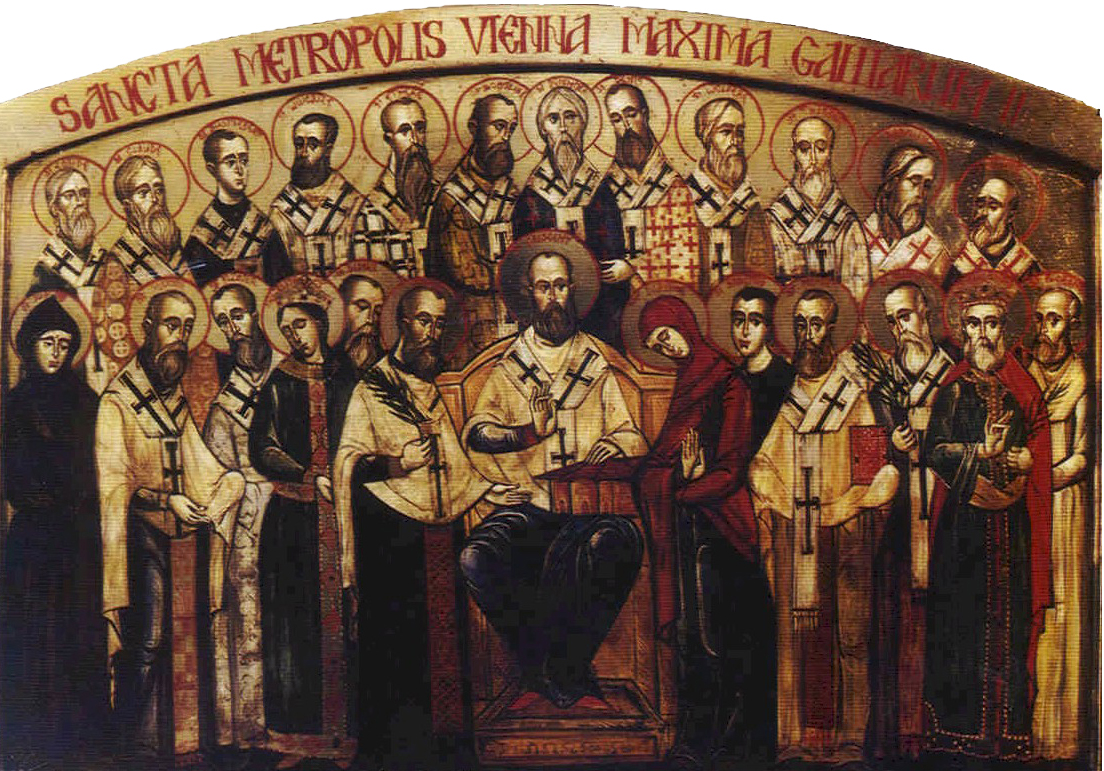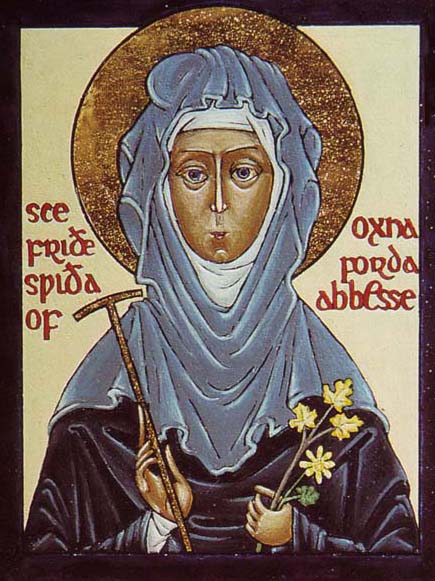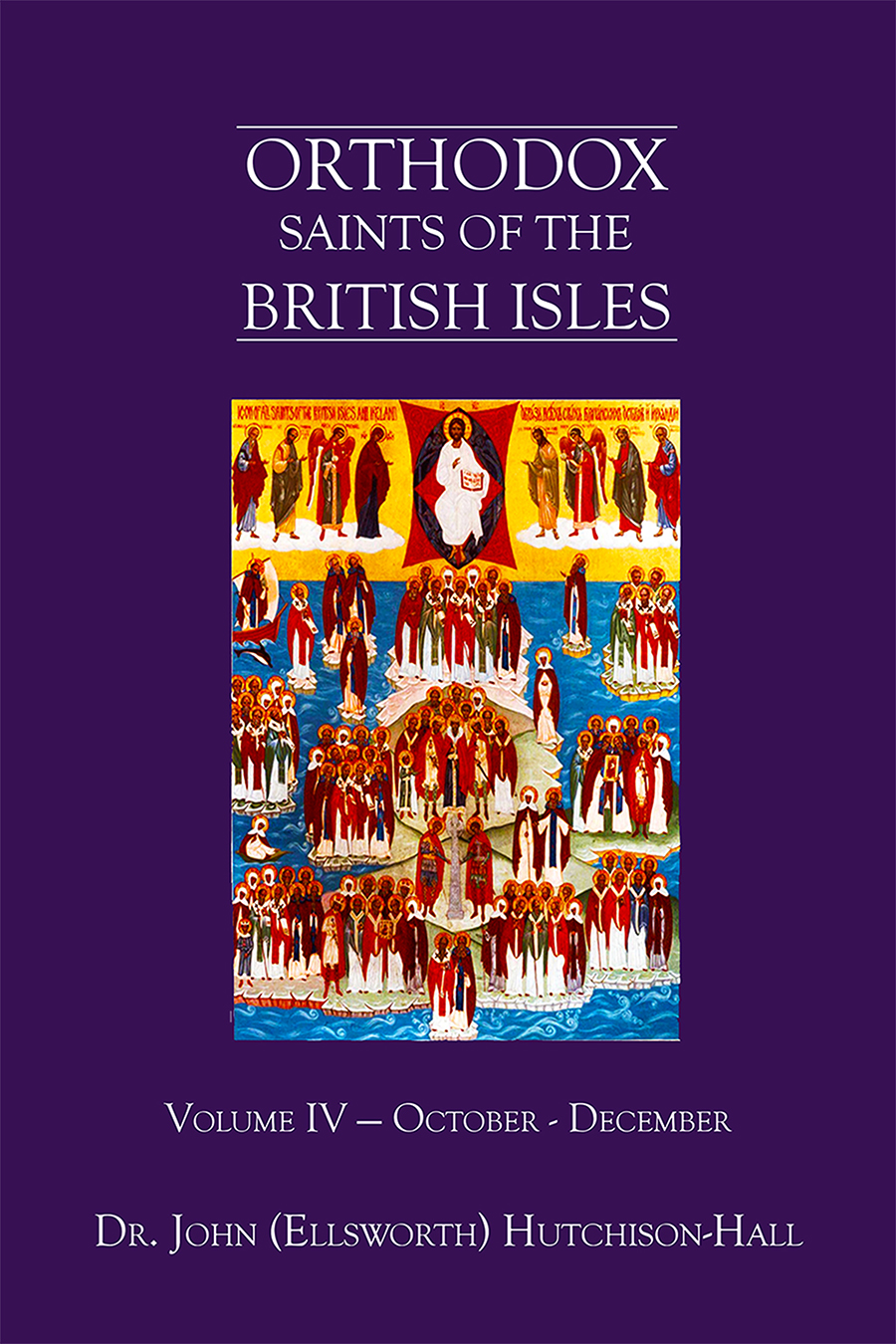
Orthodox Saints of the Pre-Schism
See of Rome
1st November (NS) — 19th October (OS) 2024
ALTINUS (ATTINUS), a first century missionary bishop who is credited with founding the churches of Orléans and Chartres (both in north-central France). There is an alternate tradition in which St. Altinus is said to have flourished in the fourth century and was a martyr.
AQUILINUS of EVREUX, returning home after fighting the Visigoths under Clovis II, King of Neustria and Burgundy (r. 639–657), St. Aquilinus, a Frankish nobleman, and his wife agreed to separate and dedicate their lives and wealth to caring for the sick and the poor. St. Aquilinus in 670 was consecrated Bishop of Evreux in Normandy (north-western France). He led more of a hermetical life than most bishops of his era. St. Aquilinus reposed in 695.
DESIDERIUS of LONGORET, a monk and disciple of St. Sigiranus (5th December) at the Abbey of St. Peter of Longoret (abbaye Saint-Pierre de Longoret) in the Diocese of Bourges (central France). St. Desiderius spent the later years of his life as a hermit in La Brenne near Bourges, reposing circa 705.
EDNOTH (EADNOT), a monk at Worcester Abbey (Worcestershire, West Midlands, England) and later Abbot of Ramsey Abbey (Huntingdonshire (now part of Cambridgeshire), England). St. Ednoth was consecrated Bishop of Dorchester in 1006, with his seat at Dorchester Abbey in Dorchester-on-Thames in Oxfordshire. In 1016 St. Ednoth was martyred by the Danes.
ETHBIN, born in Britain to a noble family, and educated in Brittany (north-western France) by St. Samson of Dol (28th July). Following his ordination to the Diaconate in 554 by St. Sampson, St. Ethbin entered Taurac Abbey where he remained until its sack by the Franks in 556. He then went to Ireland where he spent the rest of his life as a hermit in a forest near Kildare (mid-eastern Ireland). St. Ethbin reposed circa 625.
EUSTERIUS of SALERNO, (Fifth Century), the fourth Bishop of Salerno (south-western Italy). No further details are extant.
FRITHUSWITH (FRIDESWIDE) of OXFORD, the patron saint of the city and University of Oxford. We are entirely dependent on a brief account by the distinguished twelfth century English historian, man of letters, and monk, William of Malmesbury (†c. 1142), and two twelfth century Lives for any information on her life. According to these, St. Frithuswith was the daughter of Didanus, ‘King of Oxford’, and following the death of her mother, while St. Frithuswith was still a child, she received monastic tonsure and entered the double monastery of St. Mary the Virgin which had been founded by her father, serving as its first Abbess. The Lives also report she was miraculously transported to Bampton Oxfordshire, where she hid for three years, to escape the amorous attentions of Algar of Leciester. During this time, Algar is said to have tried to storm Oxford, it is assumed to take St. Frithuswith, but was struck dead at the town gates. St. Frithuswith then returned to Oxford and continued to serve as Abbess until her repose in either 727 or 735. St. Frithuswith is also believed to have spent some time at Binsey, near Oxford, where a holy well appeared in answer to her prayers. At some point following her repose her monastery came to be called after her, and there was a shrine containing her relics. The monastery was destroyed in 1002 during the St. Brice's Day massacre. Subsequent monastic houses at the site maintained a shrine for her relics, though during the Reformation, the Dissolution of the Monasteries in England and Wales (1536–1540) by Henry VIII, King of England and Ireland, (r. 1509–1547), and after, her shrine was repeatedly vandalised, and the ultimate disposition of her relics is debated. The present-day Cathedral Church of Christ which is both the chapel of the Oxford college Christ Church, as well as the cathedral of the Church of England Diocese of Oxford is located on the site of St. Frithuswith’s monastery. Though her feast was abolished during the Reformation, it remained on the Oxford University Calendar, and a service attended by University and civic dignitaries is held on, or near, 19th October.
Troparion of St. Frithuswith — Tone V
Come, let us solemnly rejoice today,
and let us laud the virtues and struggles of the most splendid luminary of the Western lands:
Frithuswith, great among ascetics, the most praiseworthy instructor of nuns,
who watcheth over us from her dwelling-place on high;
for the Lord hath truly made her wondrous among His saints.
By her supplications may He save our souls.
LAURA of CÓRDOBA, born in Córdoba, she became a nun at Cuteclara following the death of her husband, eventually becoming Abbess. One of the 48 Martyrs of Córdoba, St. Laura was thrown into a cauldron of molten lead by the Moors in 864.
LUPUS of SOISSONS, a nephew of St. Remigius of Rheims (1st October), St. Lupus served as thirteenth Bishop of Soissons (northern France) from 505 until his repose circa 540.
PTOLEMY of ROME and LUCIUS of ROME, martyred circa 160 in Rome during the reign of the Emperor Antoninus Pius (r. 138–161). St. Ptolemy was put to death for catechising or baptising a woman. Lucius and an unnamed man protested the sentence, and when questioned by the Court, declared themselves to be Christians, and were also martyred. Their martyrdom was recorded by their contemporary, St. Justin the Philosopher (1st June).
THEOFRID (THEOFROY, CHAIFRE), a monk and later Abbot of Calmeliac (present-day Le Monastier-sur-Gazeille, France). St. Theofrid was beaten to death by invading Moors in 728.
VERANUS of CAVAILLON, a Bishop of Cavaillon (south-eastern France) who reposed in 590. He is remembered for his charitable works and patronage of monasteries in his See. St. Gregory of Tours (17th November) related several miracles performed by St. Veranus, including driving out a dragon.
Get your copy of Orthodox Saints of the British Isles today.
Available at Amazon or your favourite e-bookstore.
AMABILIS, brought to Clermont in Auvergne by St. Sidonius Apollinaris (21st August), where St. Amabilis initially served as the chanter at the church of St. Mary, and later as precentor at the cathedral of Clermont (at that time dedicated to SS. Vitalis and Agricola [4th November]). Later he served as a parish priest in Riom in Auvergne, about 8 mi / 13 km north of Clermont. St. Amabilis reposed in 475.
AUSTREMONIUS (STREMOINE), (Third Century), one of seven missionaries sent from Rome to evangelise Gaul. St. Austremonius focused his attentions on the Auvergne, and later served as the first Bishop of Clermont-Ferrand. There is a common pious belief in France that St. Austremonius was one of the missionaries sent to evangelise Gaul by the Apostle St. Peter (29th June), however there is no evidence to support this.
BENIGNUS, (Second Century), the Enlightener of Burgundy. St. Benignus was martyred during the reign of Emperor Marcus Aurelius (r. 161–180). In the early sixth century, St. Gregory of Langres, the then Bishop) had a basilica built over his tomb, which today is the Cathedral of Saint Benignus of Dijon (Cathédrale Saint-Bénigne de Dijon).
CADFAN of WALES, (Sixth Century), a native of Brittany, St. Cadfan went to Wales where he became the founding Abbot of St. Mary’s Abbey on Bardsey Island. St. Cadfan is also credited with the founding of churches in Llangadfan in northern Powys, and at Tywyn in Gwynedd. He is believed to have reposed at Bardsey, most likely at the end of the fifth or beginning of the sixth century.
Troparion of St. Cadfan — Tone VIII
Leaving thy native Brittany for the love of Christ, O Father Cadfan,/
thou dost teach us not to love places or things more than Him./
Wherefore, O holy one, intercede for us/
that we may be faithful to our calling and found worthy of great mercy.
CAESARIUS and JULIAN, (Date Unknown), two clerics from Africa, Caesarius, a deacon, and Julian, a priest, were martyred in Terracina after identifying themselves as Christians and protesting the human sacrifice they came upon. The church of St. Caesarius on the Appian Way is dedicated to St. Caesarius.
CAESARIUS, and early seventh century Bishop of Clermont of whom there is no information extant. St. Caesarius is said to have reposed circa 627.
CEITHO, (Sixth Century), St. Ceitho, along with his four brothers, SS. Gwyn, Gwynno, Gwynoro, and Celynin are commemorated in the name of the Church of St. Celynin, Ceitho, Gwyn, Gwyno and Gwynoro in Llanpumsaint (Welsh: “Llan” church + “pum” five + “saint” saint(s)), Carmarthenshire, Wales. Nothing further is known of these saints, and the only mention of them occurs in the Demetian Calendar, (the earliest known copy of which is in the Cwrtmawr Manuscripts 44 in the collection of the National Library of Wales, which dates from the sixteenth century); and reads:
“The Festival of the Five Saints (Y Pumpsaint) is on the Festival of All Saints [1st November]. These five were brothers, who were born the same time, at one birth, of one woman. Their father was named Cynyr Farfwyn, of the parish of Cynwyl Gaio, in Carmarthenshire; and their names were Gwyn, Gwyno, Gwynoro, Celynin, and Ceitho. Ceitho has a special Festival (August 5).”
It appears that at some point St. Ceitho was no longer commemorated on 5th August, and the feast on 1st November came to commemorate St. Ceitho exclusively. In later documents St. Ceitho is listed as the abbot-founder of a monastery at Llangeitho in Ceredigion where he lived as a hermit. There the village church is named for St. Ceitho, and his holy spring is nearby. The spring’s water is said to run cool in summer and warm in winter.
Troparion of St. Ceitho — Tone VIII
As God's earthly house is the very Gate of Heaven/
O holy Ceitho, in thy foundation thou didst open to men the way of salvation./
Wherefore, O Saint, pray that we, entering this holy temple,/
may worthily stand before God and implore Him to grant mercy to our souls.
CLEDWYN (CLYDWYN), (Fifth Century), St. Cledwyn is the patron saint of Ynys Llanddwyn (Llanddwyn Island) off the west coast of Anglesey, North Wales. It has been said that he might have been the eldest son of King St. Brychan of Brycheiniog (6th April), and that St. Cledwyn succeeded him as ruler of, at least part of, his realm. There is no reliable documentation to support this and nothing further is known of his life.
DINGAD, (Fifth Century), according to both the De Situ Brecheniauc and the Cognacio Brychan (Wade-Evans 1906), St. Dingad was a son of Welsh King St. Brychan of Brycheiniog (6th April). He lived as a hermit in the area now known as Llandovery, Carmarthenshire, Wales.
FLORIBERT (FLORBERT), an abbot of monasteries in Ghent, Mont-Blandin, and Saint-Bavon, in present-day Belgium. St. Floribert reposed circa 660.
GENESIUS, the thirty-seventh Archbishop of Lyons, St. Genesius served as the chaplain to the court and camp of King Clovis II and chief almoner to Queen Saint Bathildis (30th January). He received monastic tonsure at Abbey of St. Peter (later the Abbey of St. Wandrille) in Fontenelle, Normandy, and some sources claim (without evidence) he was an abbot there. St. Genesius is credited with chartering the Royal Abbey of St. Peter of Corbie (Picardy). St. Genesius reposed circa 679.
GERMANUS of MONTFORT, a priest-monk at the abbey Saint Martin of Savigny in the Rhône, and later Prior of the community that became the Abbey of Talloires in Haute-Savoie. St. Germanus spent the last years of his life as a hermit at Montfort in Brittany, where he reposed in 1000.
LICINIUS (LESIN), a member of the Court of Clotaire, King of Soissons, and Count of Anjou. St. Licinius renounced his title and received monastic tonsure. He was consecrated Bishop of Angers by St. Gregory of Tours (17th November) in 586, and served that See for approximately 30 years, until his repose circa 618.
MARCELLUS (MARCEL), a Bishop of Paris, reckoned by some sources to have been the ninth prelate of that See. St. Marcellus was chosen bishop by the acclimation of people and clergy due to his renowned virtue and wonder-working. He reposed circa 436, and was buried in the old Christian cemetery located outside the walls of the city.
MARY the SLAVE, a slave in the household of a Roman noble. St. Mary was martyred for her faith in Christ during the Diocletianic Persecution at the beginning of the fourth century.
MATHURIN (MATURINUS), a pagan, whose father at one time was commissioned by Emperor Maximian (r. 286–305) to massacre all Christians in the country. St. Mathurin was converted at age 12 by Polycarp, Bishop of Sens, who then Priested him at 20. St. Mathurin's zeal brought many to Christ, including, it is said, his parents. He was blessed with the gift of wonder-working especially as an exorcist. St. Mathurin reposed in Rome circa 388.
PABIALI, (Fifth or Sixth Century), St. Pabiali is thought to have been the descendant of an unnamed local Welsh King, and patron of a chapel called Partypallai in a now unknown location in Wales. No reliable information on this saint has survived.
Troparion of SS. Pabiali, Cledwyn, and Dingad — Tone IV
Treasures of the legacy of Brychan,/
noble ascetics and teachers of the Orthodox Faith,/
O pious Pabiali, Cledwyn and Dingad,/
who make this day illustrious with your memory:/
cease not in your intercessions before the Throne of Grace/
that Christ our God will be gracious to us/
and show us great mercy.
SEVERINUS, a monk or hermit at Tivoli in Lazio. He reposed circa at the beginning of the seventh-century, and his relics are enshrined at the church of St. Laurence in Tivoli.
VIGOR, a disciple of St. Vedast, of Arras (6th February), who spent year working to enlightening pagans in Bayeux and surrounding areas. St. Vigor was consecrated Bishop of Bayeux in 513, and continued to bring people to Christ, until his repose circa 530.
Prior to the Schism the Patriarchate of Rome was Orthodox, and fully in communion with the Orthodox Church. As Saint John of Shanghai and San Francisco +1966 said “The West was Orthodox for a thousand years, and her venerable Liturgy is far older than any of her heresies”.
Details of British Saints excerpted from Orthodox Saints of the British Isles.
Details of continental saints from these sources.
In many cases there are several spelling versions of the names of saints from the British Isles. I use the Oxford Dictionary of National Biography version as the primary version with the more prevalent version in parenthesis e.g. Ceadda (Chad) of Lichfield.


